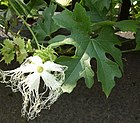Note: This is a project under development. The articles on this wiki are just being initiated and broadly incomplete. You can Help creating new pages.
Trichosanthes kirilowi - Chinese cucumber
Trichosanthes kirilowii is a flowering plant in the family Cucurbitaceae. It is found particularly in Henan, Shandong, Hebei, Shanxi, and Shaanxi. It is one of the 50 fundamental herbs used in traditional Chinese medicine.
Uses
Parts Used
Chemical Composition
The plant is a source of the ricin-like protein trichosanthin[1]
Common names
| Language | Common name |
|---|---|
| Kannada | |
| Hindi | Khira / Kheera / Kakdi |
| Malayalam | Vellarikka |
| Tamil | Vellarikka |
| Telugu | |
| Marathi | NA |
| Gujarathi | NA |
| Punjabi | NA |
| Kashmiri | NA |
| Sanskrit | |
| English | Cucumber |
Properties
Reference: Dravya - Substance, Rasa - Taste, Guna - Qualities, Veerya - Potency, Vipaka - Post-digesion effect, Karma - Pharmacological activity, Prabhava - Therepeutics.
Dravya
Rasa
Guna
Veerya
Vipaka
Karma
Prabhava
Habit
Identification
Leaf
| Kind | Shape | Feature |
|---|---|---|
| Simple | large | lThe Leaves (10-20 cm in the regular cucumber, 20-40 cm in the seedless cucumber) are each borne on long (7-20 cm) petioles |
Flower
| Type | Size | Color and composition | Stamen | More information |
|---|---|---|---|---|
| Unisexual | 2-4cm long | Yellow | 5-20 | The flowers which are mostly either male or female. The female flowers are recognized by the swollen ovary at the base, which will become the edible fruit |
Fruit
| Type | Size | Mass | Appearance | Seeds | More information |
|---|---|---|---|---|---|
| triangular | 5-20cm | In the immature fruit, chlorophyll in the cells under the epidermis causes the rind to be green, but, upon maturity, it turns yellow-whit | the fruit is a false berry or pepo | many seeds | {{{6}}} |
Other features
List of Ayurvedic medicine in which the herb is used
Where to get the saplings
Mode of Propagation
How to plant/cultivate
Seed - sow March in pots in a warm greenhouse in a rich soil. Sow 2 - 3 seeds per pot and thin to the strongest plant. [3]
Commonly seen growing in areas
Photo Gallery
References
External Links
Categories:
- Ayurvedic Herbs known to be helpful to treat Cold
- Ayurvedic Herbs known to be helpful to treat HIV
- Ayurvedic Herbs known to be helpful to treat High cholesterol
- Ayurvedic Herbs known to be helpful to treat Psoriasis
- Ayurvedic Herbs known to be helpful to treat Indigestion
- Ayurvedic Herbs known to be helpful to treat Constipation
- Herbs with Leaves used in medicine
- Herbs with Whole herb used in medicine
- Herbs with common name in Hindi
- Herbs with common name in Malayalam
- Herbs with common name in Tamil
- Herbs with common name in English
- Habit - Shrub
- Index of Plants which can be propagated by Seeds
- Herbs that are commonly seen in the region of Semitropical plant
- Herbs that are commonly seen in the region of High temperature
- Herbs that are commonly seen in the region of Humidity
- Herbs
- Cucurbitaceae




